See also: Compare our range of dogsled tours | When to go dog sledding
Everything you ever wanted to know about dog sledding but were afraid to ask!
Dog sledding is a unique experience, and one of our most popular winter activities. We've collected the answers to questions our clients commonly ask about our range of dog sledding holidays in Sweden, Norway and Finland.
Whether you are an experienced musher or a novice yet to discover the thrills and adventure of dog sledding, we hope that you will find the information helpful to give you an idea of what to expect from your mushing holiday.
We love talking dog sledding, so if you have a question that's not answered here, or would like help choosing the best dogsled tour for you, don't hesitate to get in touch!
- How many dogs are there in a dogsled team?
- Can I drive my own dogsled if I haven't been dog sledding before?
- How fast does a dogsled go?
- What happens on a typical day during a hut-to-hut or winter camping dog sledding tour?
- What distance do you cover in a day of dog sledding?
- What is the accommodation like on a multi-day dog sledding tour?
- Is dog sledding suitable for solo travellers?
- How many people will be in the group during my dog sledding tour?
- What nationalities/age ranges will be in my group?
- Is dog sledding suitable for children?
- How fit or strong do I need to be to go dog sledding?
- Is there a maximum age limit for dog sledding?
- What clothing will I need to go dog sledding?
- Where are the best places to go dog sledding?
- Will I see the Northern Lights during my dogsled tour?
- What is the best time of year to go dog sledding in Sweden, Norway or Finland?
How many dogs are there in a dogsled team?
If you are driving your own sled for your dog sledding tour, you will normally have 3-5 huskies in your dogsled team. This varies depending on factors such as the particular dogs used, the nature of the tour/terrain, trail conditions, and the weight of individual participants.
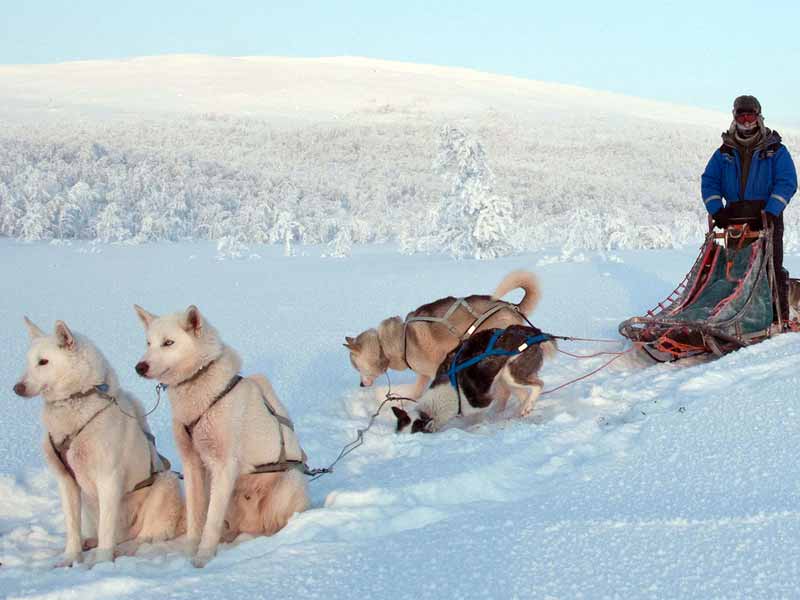
Photo: Jonathan Lamb
Can I drive my own dogsled if I haven't been dog sledding before?
Yes, you can. All our tours are based on adult participants driving their own dogsled*. Full instruction will be given from an experienced and knowledgeable local guide and help and advice is always on hand. Usually people become quite confident at handling the sled and the dogs within a day and you should be surprised how quickly you relax and gain confidence.
Some of our more challenging dogsled tours do require previous experience and are ideal for those seeking a "next step" trip. See website information for your chosen tour for details.
Take a look at our blog article How to drive a dogsled to find out more!
*For One-day and Overnight Husky Tours in Kiruna, there is the option to drive own sled or share one per two persons. For Aurora Husky Adventure in Finnmark, the tour normally begins with using a "tandem" sled, where you share a sled one per wo persons and both participate in driving at the same time (that is, neither person is riding as a passenger). For information on dog sledding for families and possibilities for children to drive, for example for Discover Dog Sledding in Lapland, please see information on the relevant tour page.
How fast does a dogsled go?
The speed of a dogsled depends on snow consistency, weather conditions, the weight carried and of course whether the sled is travelling up or downhill, but generally you will travel at 5-15km/hour when dog sledding.
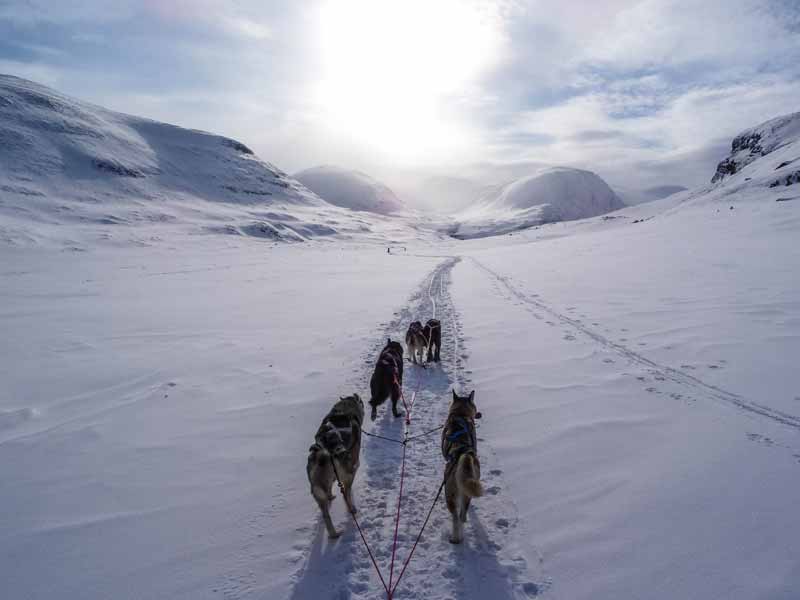
Photo: James Padolsey
What happens on a typical day on a hut-to-hut or winter camping dog sledding tour?
This will vary depending on the tour and whether you are sledding to a new overnight location or doing a day tour returning to the same location.
On a normal dog sledding day during an extended tour you will get up, make a fire, heat water for the dogs, go out and feed the dogs and clear the dog toilet waste. Then you have breakfast, pack everything together, clean out the cabin or break camp, load the sleds and start the journey for the day. During the day, you will stop to have lunch outdoors along the way, perhaps preparing lunch over an open fire.
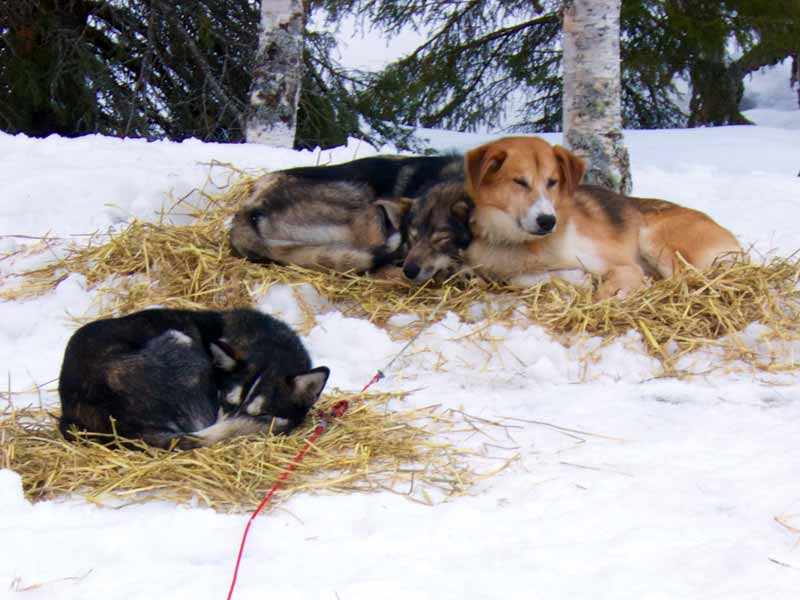
Photo: Corinne McManus
When you reach your destination for the day, you will prepare the dogs for the night. Exact procedure for this will vary depending on the tour and on the weather, but will often involve putting the dogs on a long wire and if necessary maybe even digging a wall of snow for the dogs to protect them from the wind. Depending on facilities and your accommodation for the night, you may need to melt water for the dogs to drink. After feeding and seeing to the dogs, it's time to relax and enjoy your evening - reflecting on the day's adventures with your fellow mushers, preparing and cooking dinner together and maybe even taking a sauna to soothe those tired muscles!
What distance do you cover in a day of dog sledding?
Distance covered by dogsled in a day varies considerably depending on a number of factors, such as terrain, the weight carried in the sleds, weather conditions, snow consistency and your planned route. Available daylight hours also vary of course depending on the time you wish to go (darkest in November/December getting gradually lighter until the end of the dog sledding season). Typical distance covered during a dogsled tour is around 20-50km per day depending on the terrain.
What is the accommodation like on a multi-day dog sledding tour?
Accommodation during a dogsled tour varies depending on the tour - please see the information for your chosen tour for details - but in general will be either in simple cabins, winter camping or a combination of the two. Sauna facilities may be available at some locations. For all multi-day point-to-point cabin tours, sleeping accommodation while out on the tour will always be shared in simple but cosy wilderness cabins (accommodation at the start/end near the kennels may be private - see tour information for details).
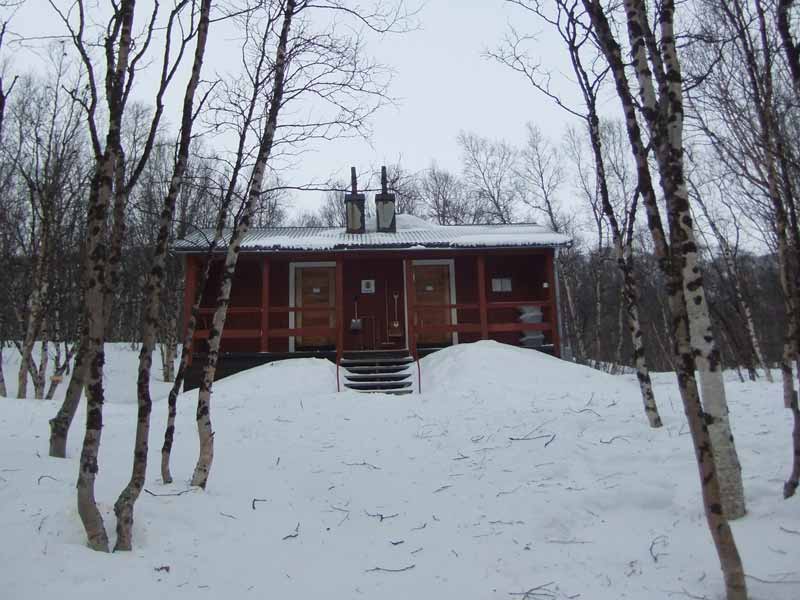
Photo: Nature Travels
Cabins along the route will normally have shared sleeping rooms with bunk beds and facilities for cooking. Many cabins do not have electricity or running water - this is very much part of the wilderness experience - and everyone assists with tasks such as fetching water, chopping wood, and assisting with cooking/washing up, etc.
For some tours, accommodation is wild winter camping along the way - a unique and challenging experience!
Is dog sledding suitable for solo travellers?
Yes. Dog sledding is very popular with solo travellers and all our husky tours are ideal for those travelling solo. As sleeping accommodation is shared, there is no single supplement for solo travellers. Exact group composition will of course vary, but a typical dogsled group will often consist of a mix of solo travellers and guests travelling with one or more travel partners.
How many people will be in the group during my dog sledding tour?
For our scheduled dogsled tours, there is a maximum of 4-8 participants depending on the tour.
See tour information for details. Some of our husky tours, such as Northern Lights Dog Sledding in Lapland and Husky Mountain Expedition in Lapland are also ideal for larger groups, for example for Armed Forces adventurous training expeditions (groups larger than 8 persons will normally be divided into smaller groups to follow parallel itineraries, both for safety reasons and to maintain the quality of the experience).
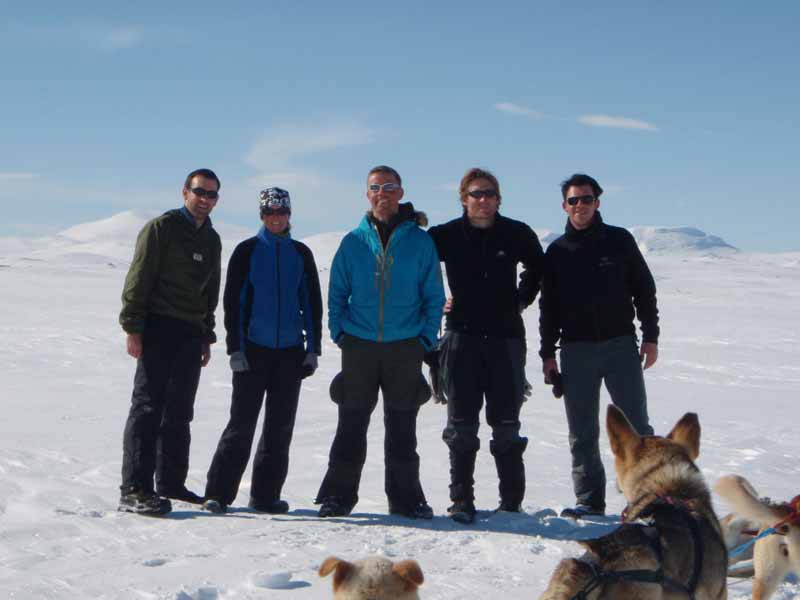
Photo: Ryan Pape
What nationalities/age ranges will be in my group?
Our dogsled tours are open to guests from all over the world. Group composition will of course vary, but guests will often be a mix of nationalities such as UK, mainland European and participants from further afield such as Australia and the US. All guides will speak English and English is widely spoken to a high standard throughout the Nordic countries.
Age ranges will vary depending on the tour - see tour information for details and min. age requirements. For tours intended for adult participants, typical age range would normally be from early 20s to late 50s, though we have had many guests in their 60s and even 70s participating very successfully in even some of our most challenging tours.
Is dog sledding suitable for children?
Yes, dog sledding is a wonderful experience for active families. Huskies are friendly and affectionate, and children love interacting with them.
A number of our dogsled tours are suitable for adults only or for families with older children, while some are also ideal for younger children (min. age 6).
Apart from One-day and Overnight Dogsled Tours in Kiruna and Discover Dog Sledding in Lapland, which are ideal for a family-friendly dogsled tour, in general dog sledding is not suitable for younger children, though for private tours it is often possible to accommodate younger children than would be possible on the public tours. Please see the information for your chosen tour for details of age limits and other requirements. For some tours, older children aged 13-16 are certainly possible.
How fit or strong do I need to be to go dog sledding?
You will need a general good level of fitness and strength to go dog sledding, especially when driving your own sled.
The level of fitness required will depend on the tour you choose (terrain, length of tour, whether it's a cabin or a winter camping tour). The weather, temperature and snow conditions you encounter can also greatly affect the level of challenge - dog sledding on hard-packed trails under clear blue skies is much easier than sledding through deep snow in a blizzard!
We offer a very wide range of dogsled tours with levels of challenge from quite easy to very hard - please see tour information for your chosen tour for details.
For all tours, you should be in generally good health and enjoy the outdoors, as well as be comfortable living in close proximity with others. Some strength is required, particularly when braking the sled when travelling downhill (this is very important, as a poorly-controlled sled can overtake and injure the dogs) or assisting your team when travelling uphill.
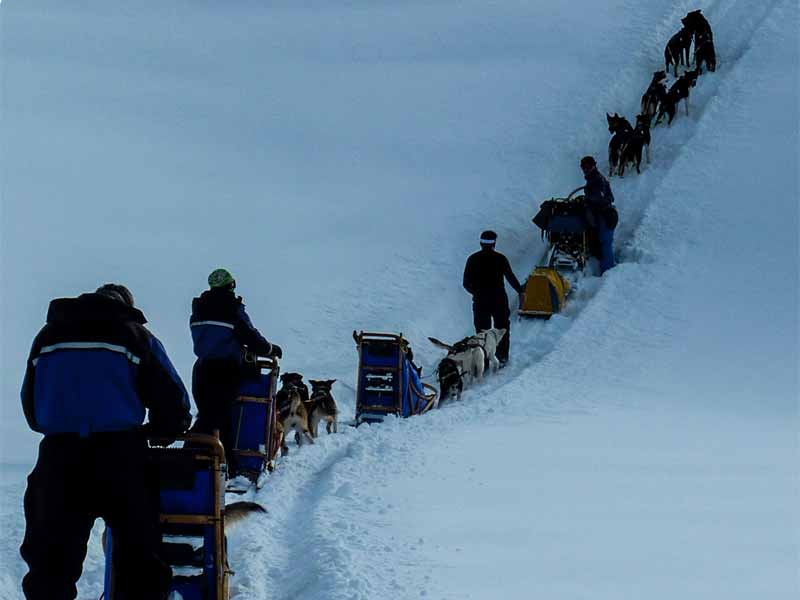
Photo: Tom Smith
Is there a maximum age limit for dog sledding?
No. There is no fixed upper age limit - a number of clients in their 60s or above have participated very successfully in even our most challenging husky tours. The most important thing is a willingness to get involved and work with the sled and dogs.
It is of course important that you are comfortable with the physical demands of your chosen tour - if you have any questions or concerns, please don't hesitate to ask and we will be very happy to discuss the most suitable option for you.
Note that the level of challenge of any tour will be significantly affected by weather and snow conditions - sledding on hard-packed snow under clear blue skies is much less physically challenging than sledding in fresh, deep snow in a blizzard!
What clothing will I need to go dog sledding?
For all our dog sledding holidays in Sweden, Norway or Finland, specialist winter outer clothing you will need for your tour is included, which normally consists of warm outer layer (usually a snowmobile suit), warm boots, hat and gloves. Clothing provided varies slightly depending on the tour - see tour information for details.
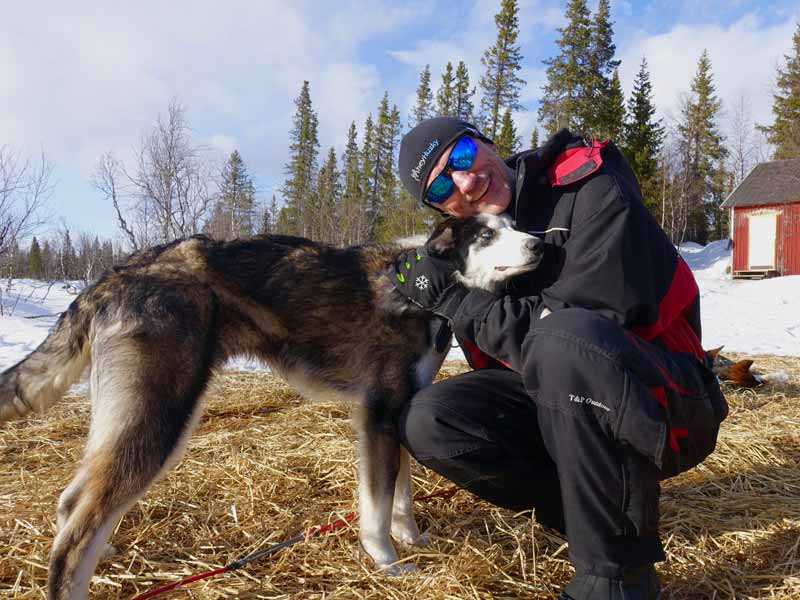
Photo: Lydia Lam
Participants will normally need to bring only their own base and mid-layer clothing. A detailed recommended packing list will be included in your booking documentation.
For your clothing, we recommend you use the layer principle:
- Closest to your body an inner layer that transports humidity away from the body, such as a woollen base layer top and long-johns.
- Then a second layer that keeps in the warmth your body generates and absorbs the humidity from the inner layer, such as a fleece or jumper.
- The outer layer should protect you from weather and wind and be wind- and waterproof. This is normally a snowmobile suit and is provided as standard for our tours.
- You should also have something to cover your face, such as a scarf or Buff, and ski glasses or goggles to protect your eyes and improve vision.
Do not use cotton on the inner layers closest to your body, as cotton collects the humidity your body generates. The clothing gets heavy and chills you. Better materials to use are synthetics, wool etc.
Where are the best places to go dog sledding?
Sweden, Norway and Finland of course! In Sweden and Finland, our dog sledding experiences take place in the far north, in Swedish and Finnish Lapland. In Norway, we offer options in central Norway and in the far north of Norway. All these regions offer wonderful opportunities for dog sledding. Landscapes vary from frozen lakes and forest to tundra to stunning mountain areas. See our article comparing our range of dogsled tours for more information.
Whichever region you choose, you will find dog sledding is an unforgettable experience.
Will I see the Northern Lights during my dogsled tour?
Dog sledding gives you very good chances to see the Northern Lights. The Northern Lights, or Aurora Borealis, is a natural phenomenon, and so of course displays can never be guaranteed. In general, the best chances for displays of the Northern Lights during your dogsled tour are, as the name suggests, in the far north, close to or inside the Arctic Circle, though displays do also occasionally occur further south.
Displays can be seen in the far north from late Autumn to around early April and so are visible during almost the whole the dogsled season, except for the latest part of the "spring winter" from mid-April to May (which is nevertheless a wonderful time for dog sledding!).
To see the Northern Lights you need three things: the sky must be clear (with little or no light pollution around), there must be Aurora activity, and you must be awake!
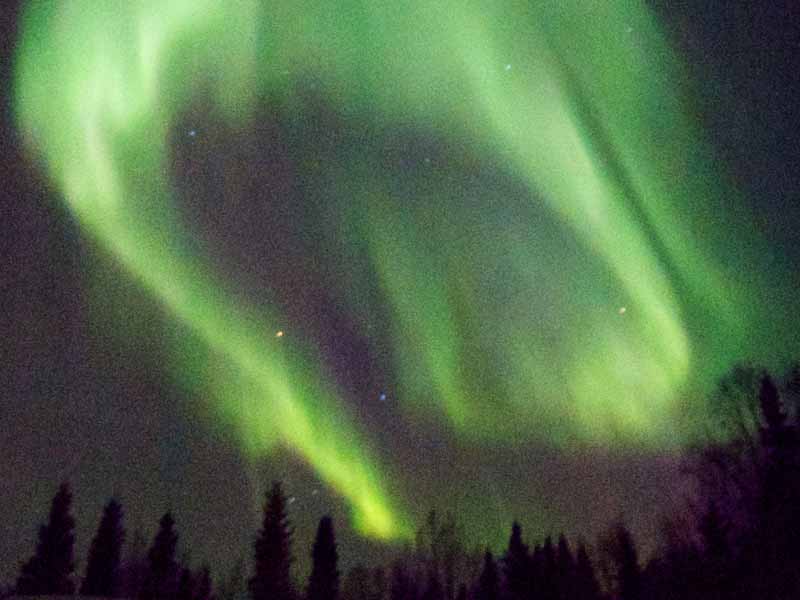
Photo: Ben Roberts
Many guests travelling with for dog sledding have an interest in the Northern Lights. However, we recommend that you see the excitement of the activity and the beauty of the landscapes as the main motivation for travelling and regard a display of the Northern Lights as a bonus. Even in areas with excellent chances, it is possible that it will be cloudy, there will be no activity, or (very common) you will be fast asleep after a long day of mushing adventure!
For this reason, we strongly recommend that you also consider our tour options located in areas not normally within the "Northern Lights zone". These areas offer fantastic possibilities for dog sledding, beautiful scenery, and may even be quicker or more affordable to travel to than locations further north.
What is the best time of year to go dog sledding in Sweden, Norway or Finland?
This depends very much on personal taste and what you are looking for from your dog sledding holiday. Certain tours are only available later in the season, from late February to April, when weather conditions are suitable for dog sledding in the mountains, while others are possible throughout the season.
December and January are deep winter, when hours of daylight are shortest and temperatures tend to be lowest, but this time of year has a magical atmosphere and a special blue quality to the light. Later in the season towards March and April, the days are lengthening and the mountains have the "best of both worlds", with good snow cover but also the warming rays of the spring sunshine.
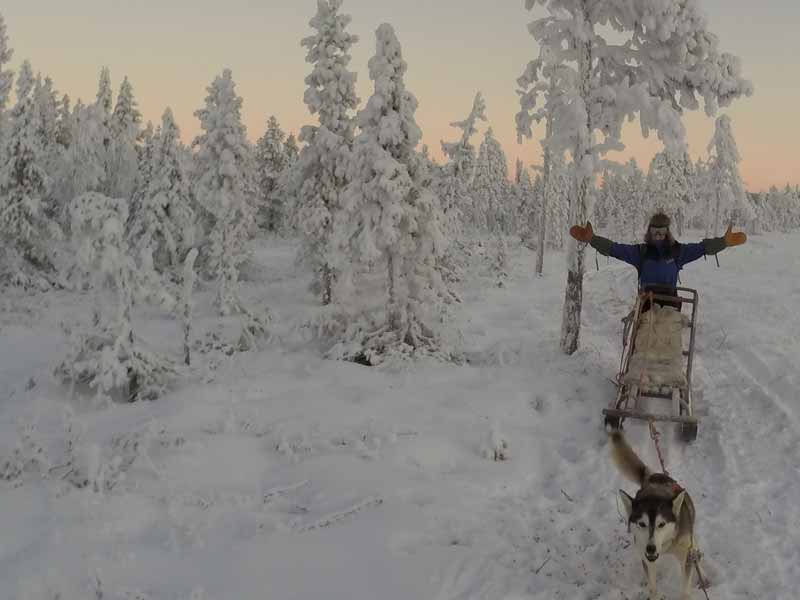
Photo: Sam Lombard
Read our article on When To Go Dog Sledding for more information.
Browse our full range of dog sledding holidays in Sweden, Finland and Norway.



